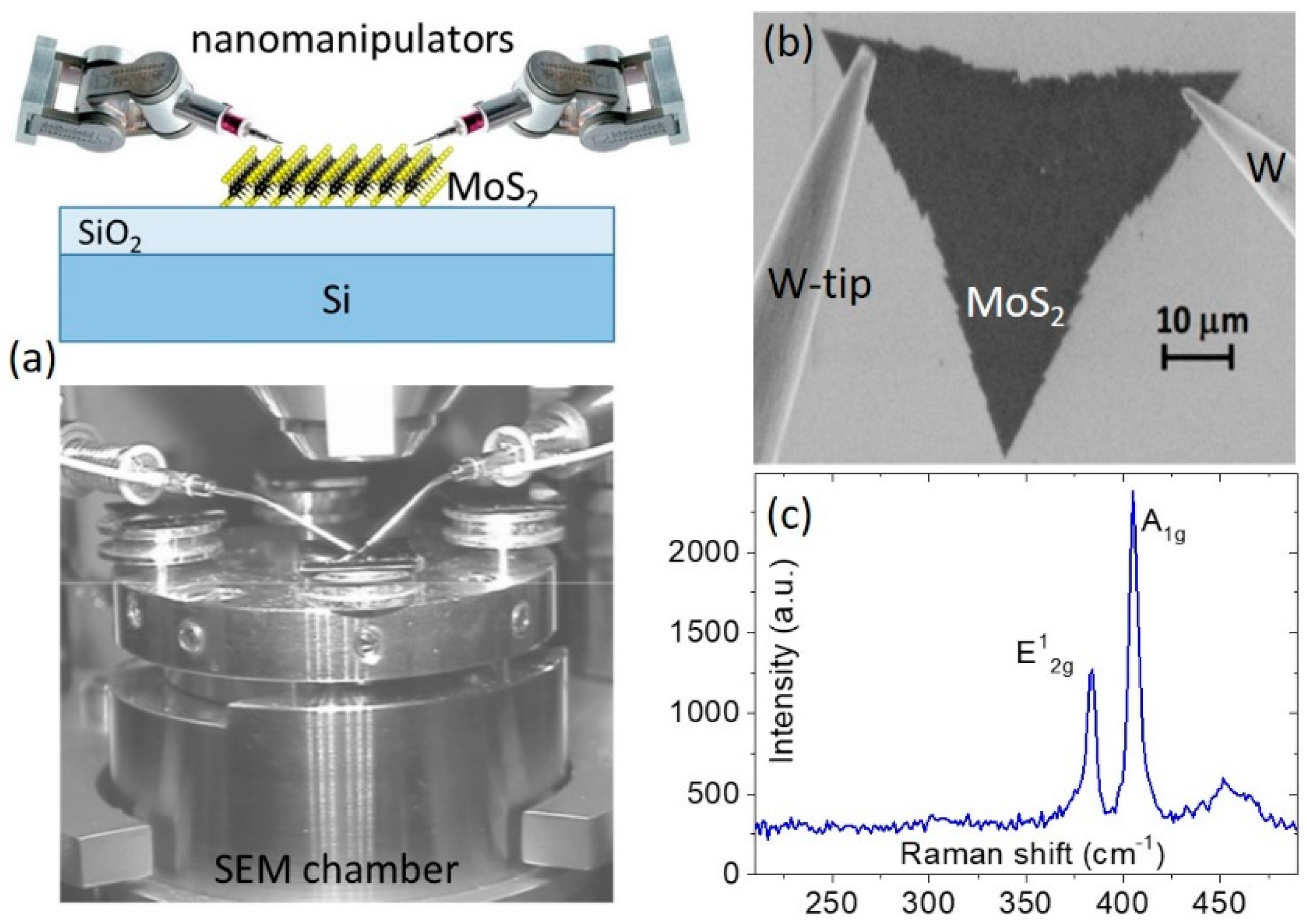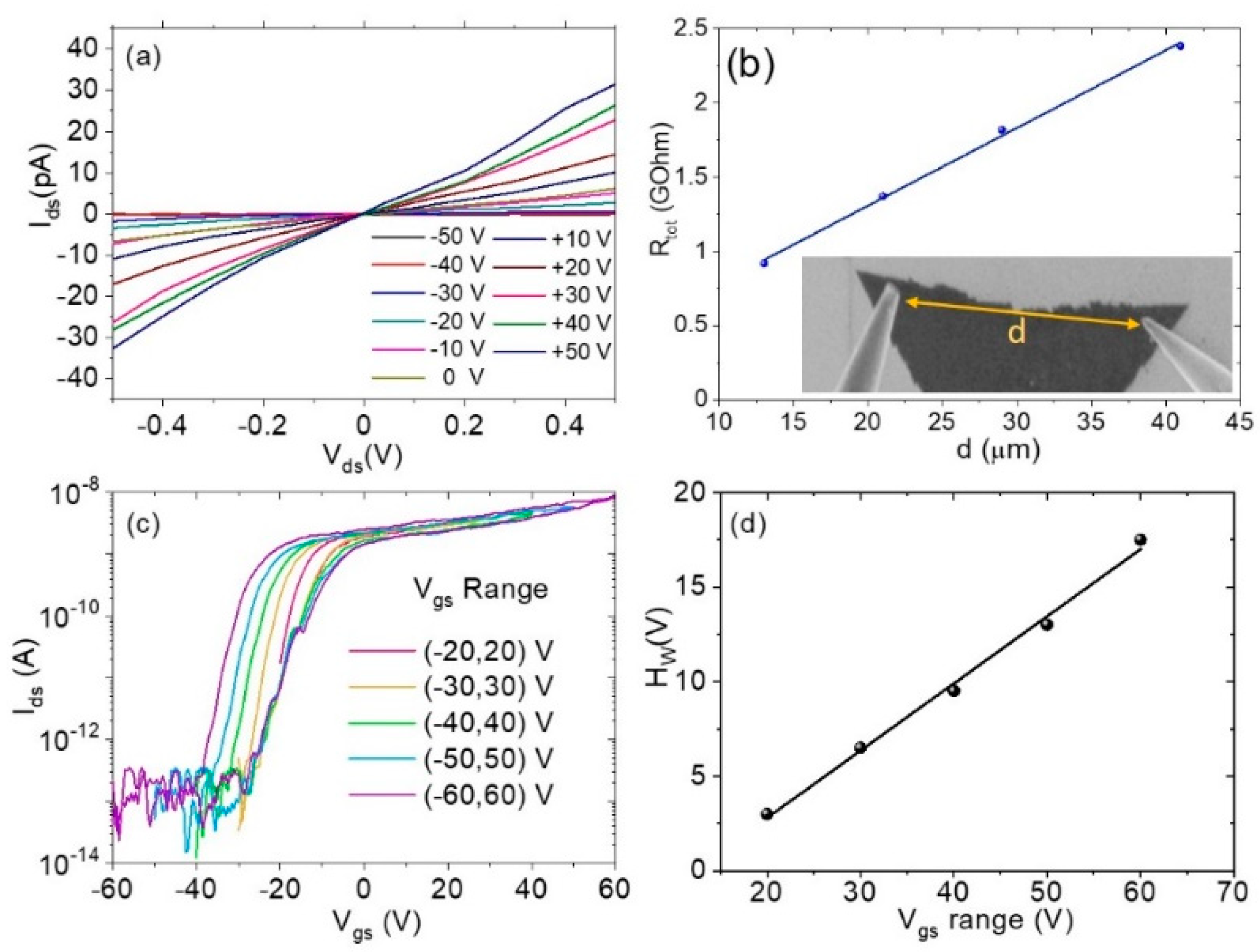Direct Contacting of 2D Nanosheets by Metallic Nanoprobes †
Abstract
:1. Introduction
2. Materials and Methods
3. Results and Discussion
4. Conclusions
Data Availability Statement
Conflicts of Interest
References
- Tong, X.; Ashalley, E.; Lin, F.; Li, H.; Wang, Z.M. Advances in MoS2-Based Field Effect Transistors (FETs). Nano-Micro Lett. 2015, 7, 203–218. [Google Scholar] [CrossRef] [PubMed]
- Seo, D.; Lee, D.Y.; Kwon, J.; Lee, J.J.; Taniguchi, T.; Watanabe, K.; Lee, G.-H.; Kim, K.S.; Hone, J.; Kim, Y.D.; et al. High-performance monolayer MoS2 field-effect transistor with large-scale nitrogen-doped graphene electrodes for Ohmic contact. Appl. Phys. Lett. 2019, 115, 012104. [Google Scholar] [CrossRef]
- Di Bartolomeo, A.; Grillo, A.; Urban, F.; Iemmo, L.; Giubileo, F.; Luongo, G.; Amato, G.; Croin, L.; Sun, L.; Liang, S.-J.; et al. Asymmetric Schottky Contacts in Bilayer MoS2 Field Effect Transistors. Adv. Funct. Mater. 2018, 28, 1800657. [Google Scholar] [CrossRef]
- Divya Bharathi, N.; Sivasankaran, K. Research progress and challenges of two dimensional MoS2 field effect transistors. J. Semicond. 2018, 39, 104002. [Google Scholar] [CrossRef]
- Hao, L.; Liu, Y.; Gao, W.; Han, Z.; Xue, Q.; Zeng, H.; Wu, Z.; Zhu, J.; Zhang, W. Electrical and photovoltaic characteristics of MoS 2 /Si p-n junctions. J. Appl. Phys. 2015, 117, 114502. [Google Scholar] [CrossRef]
- Lopez-Sanchez, O.; Lembke, D.; Kayci, M.; Radenovic, A.; Kis, A. Ultrasensitive photodetectors based on monolayer MoS2. Nat. Nanotechnol. 2013, 8, 497–501. [Google Scholar] [CrossRef] [PubMed]
- Di Bartolomeo, A.; Genovese, L.; Foller, T.; Giubileo, F.; Luongo, G.; Croin, L.; Liang, S.-J.; Ang, L.K.; Schleberger, M. Electrical transport and persistent photoconductivity in monolayer MoS 2 phototransistors. Nanotechnology 2017, 28, 214002. [Google Scholar] [CrossRef]
- Fu, H.; Yu, K.; Li, H.; Li, J.; Guo, B.; Tan, Y.; Song, C.; Zhu, Z. Enhanced field emission and photocatalytic performance of MoS 2 titania nanoheterojunctions via two synthetic approaches. Dalton Trans. 2015, 44, 1664–1672. [Google Scholar] [CrossRef] [PubMed]
- Kashid, R.V.; Late, D.J.; Chou, S.S.; Huang, Y.-K.; De, M.; Joag, D.S.; More, M.A.; Dravid, V.P. Enhanced Field-Emission Behavior of Layered MoS2 Sheets. Small 2013, 9, 2730–2734. [Google Scholar] [CrossRef]
- Giubileo, F.; Grillo, A.; Passacantando, M.; Urban, F.; Iemmo, L.; Luongo, G.; Pelella, A.; Loveridge, M.; Lozzi, L.; Di Bartolomeo, A. Field Emission Characterization of MoS2 Nanoflowers. Nanomaterials 2019, 9, 717. [Google Scholar] [CrossRef]
- Giubileo, F.; Iemmo, L.; Passacantando, M.; Urban, F.; Luongo, G.; Sun, L.; Amato, G.; Enrico, E.; Di Bartolomeo, A. Effect of Electron Irradiation on the Transport and Field Emission Properties of Few-Layer MoS 2 Field-Effect Transistors. J. Phys. Chem. C 2019, 123, 1454–1461. [Google Scholar] [CrossRef]
- Li, P.; Zhang, D.; Sun, Y.; Chang, H.; Liu, J.; Yin, N. Towards intrinsic MoS 2 devices for high performance arsenite sensing. Appl. Phys. Lett. 2016, 109, 063110. [Google Scholar] [CrossRef]
- Yan, L.; Shi, H.; Sui, X.; Deng, Z.; Gao, L. MoS 2 -DNA and MoS 2 based sensors. RSC Adv. 2017, 7, 23573–23582. [Google Scholar] [CrossRef]
- Sun, J.; Li, X.; Guo, W.; Zhao, M.; Fan, X.; Dong, Y.; Xu, C.; Deng, J.; Fu, Y. Synthesis Methods of Two-Dimensional MoS2: A Brief Review. Crystals 2017, 7, 198. [Google Scholar] [CrossRef]
- Mak, K.F.; Lee, C.; Hone, J.; Shan, J.; Heinz, T.F. Atomically Thin MoS 2: A New Direct-Gap Semiconductor. Phys. Rev. Lett. 2010, 105. [Google Scholar] [CrossRef]
- Lee, Y.T.; Kang, J.-H.; Kwak, K.; Ahn, J.; Choi, H.T.; Ju, B.-K.; Shokouh, S.H.; Im, S.; Park, M.-C.; Hwang, D.K. High-Performance 2D MoS2 Phototransistor for Photo Logic Gate and Image Sensor. ACS Photonics 2018, 5, 4745–4750. [Google Scholar] [CrossRef]
- Giubileo, F.; Di Bartolomeo, A. The role of contact resistance in graphene field-effect devices. Prog. Surf. Sci. 2017, 92, 143–175. [Google Scholar] [CrossRef]
- Giubileo, F.; Di Bartolomeo, A.; Martucciello, N.; Romeo, F.; Iemmo, L.; Romano, P.; Passacantando, M. Contact resistance and channel conductance of graphene field-effect transistors under low-energy electron irradiation. Nanomaterials 2016, 6, 206. [Google Scholar] [CrossRef]
- Urban, F.; Lupina, G.; Grillo, A.; Martucciello, N.; Di Bartolomeo, A. Temperature and gate effects on contact resistance and mobility in graphene transistors by TLM and Y-function methods. arXiv 2019, arXiv:1912.04623. [Google Scholar]
- Di Bartolomeo, A.; Genovese, L.; Giubileo, F.; Iemmo, L.; Luongo, G.; Foller, T.; Schleberger, M. Hysteresis in the transfer characteristics of MoS 2 transistors. 2D Mater. 2017, 5, 015014. [Google Scholar] [CrossRef]
- Qi, L.; Wang, Y.; Shen, L.; Wu, Y. Chemisorption-induced n -doping of MoS 2 by oxygen. Appl. Phys. Lett. 2016, 108, 063103. [Google Scholar] [CrossRef]
- Cho, K.; Kim, T.-Y.; Park, W.; Park, J.; Kim, D.; Jang, J.; Jeong, H.; Hong, S.; Lee, T. Gate-bias stress-dependent photoconductive characteristics of multi-layer MoS 2 field-effect transistors. Nanotechnology 2014, 25, 155201. [Google Scholar] [CrossRef] [PubMed]
- Bao, W.; Cai, X.; Kim, D.; Sridhara, K.; Fuhrer, M.S. High mobility ambipolar MoS 2 field-effect transistors: Substrate and dielectric effects. Appl. Phys. Lett. 2013, 102, 042104. [Google Scholar] [CrossRef]
- Radisavljevic, B.; Kis, A. Mobility engineering and a metal–insulator transition in monolayer MoS2. Nat. Mater. 2013, 12, 815–820. [Google Scholar] [CrossRef] [PubMed]
- Urban, F.; Giubileo, F.; Grillo, A.; Iemmo, L.; Luongo, G.; Passacantando, M.; Foller, T.; Madauß, L.; Pollmann, E.; Geller, M.P.; et al. Gas dependent hysteresis in MoS 2 field effect transistors. 2D Mater. 2019, 6, 045049. [Google Scholar] [CrossRef]
- Di Bartolomeo, A.; Urban, F.; Passacantando, M.; McEvoy, N.; Peters, L.; Iemmo, L.; Luongo, G.; Romeo, F.; Giubileo, F. A WSe2 vertical field emission transistor. Nanoscale 2019, 11, 1538–1548. [Google Scholar] [CrossRef] [PubMed]
- Fowler, R.H.; Nordheim, L. Electron Emission in Intense Electric Fields. Proc. R. Soc. A Math. Phys. Eng. Sci. 1928, 119, 173–181. [Google Scholar] [CrossRef]



Publisher’s Note: MDPI stays neutral with regard to jurisdictional claims in published maps and institutional affiliations. |
© 2022 by the authors. Licensee MDPI, Basel, Switzerland. This article is an open access article distributed under the terms and conditions of the Creative Commons Attribution (CC BY) license (https://creativecommons.org/licenses/by/4.0/).
Share and Cite
Giubileo, F.; Urban, F.; Grillo, A.; Pelella, A.; Faella, E.; Di Bartolomeo, A. Direct Contacting of 2D Nanosheets by Metallic Nanoprobes. Mater. Proc. 2021, 4, 16. https://doi.org/10.3390/IOCN2020-07931
Giubileo F, Urban F, Grillo A, Pelella A, Faella E, Di Bartolomeo A. Direct Contacting of 2D Nanosheets by Metallic Nanoprobes. Materials Proceedings. 2021; 4(1):16. https://doi.org/10.3390/IOCN2020-07931
Chicago/Turabian StyleGiubileo, Filippo, Francesca Urban, Alessandro Grillo, Aniello Pelella, Enver Faella, and Antonio Di Bartolomeo. 2021. "Direct Contacting of 2D Nanosheets by Metallic Nanoprobes" Materials Proceedings 4, no. 1: 16. https://doi.org/10.3390/IOCN2020-07931
APA StyleGiubileo, F., Urban, F., Grillo, A., Pelella, A., Faella, E., & Di Bartolomeo, A. (2021). Direct Contacting of 2D Nanosheets by Metallic Nanoprobes. Materials Proceedings, 4(1), 16. https://doi.org/10.3390/IOCN2020-07931









